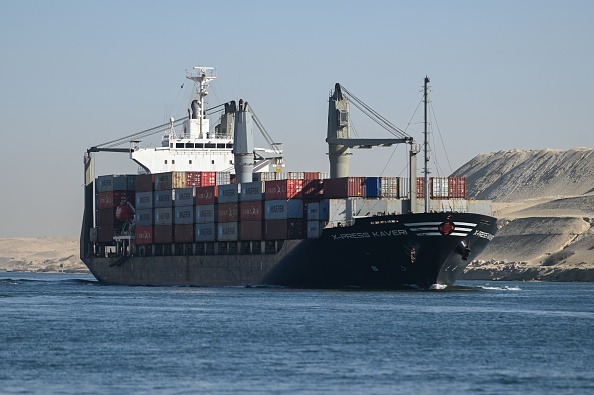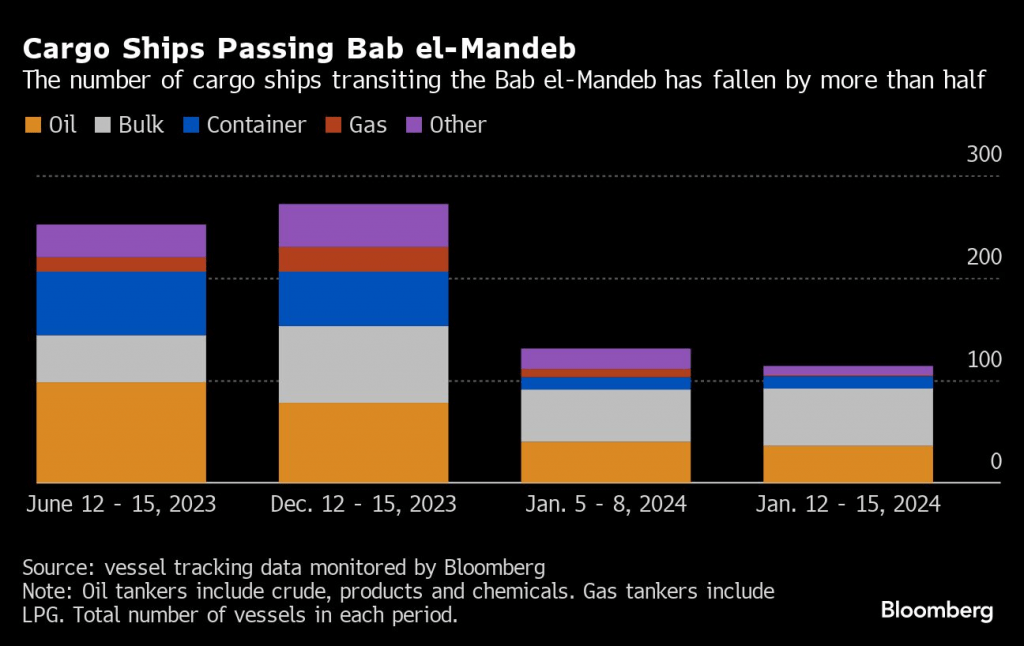Red Sea Attacks: Skyrocketing Rates Boost Marine Shipping Sector
Freight rates and stock prices are climbing higher due to marine shipping detours caused by terrorist activity around the Suez Canal

- Shipping activity in the Suez Canal has dropped precipitously as a result of the terrorist attacks on commercial vessels in the Red Sea.
- Many global marine shipping companies have adapted by detouring around the Cape of Good Hope, which has added extra costs to the Europe-Asia corridor.
- Rising freight rates have boosted the fortunes of the marine shipping sector, pushing many marine shipping stocks higher.
Major international military conflicts tend to negatively impact the global economy, and in that regard, the ongoing Israel-Hamas war is no different than its predecessors.
It’s estimated that roughly 30% of the world’s container ships were traveling via the Suez route prior to October 2023. Importantly, however, the Panama Canal has also been operating at limited capacity of late due to dangerously low water levels, which means some of the traffic between the East Coast of the United States and Asia was also being redirected through the Suez route.
Recently, the biggest complication from the Israel-Hamas war—in terms of the global economy—has been the disruption of marine shipping traffic through the area surrounding the Suez Canal, particularly in the Red Sea. The difficulties started on Oct. 19, 2023, not long after the Israel-Hamas war intensified on Oct. 7.
Then, on Oct. 19, Houthi rebels in Yemen started attacking commercial ships in the red sea using missiles, drones and other projectiles. In addition to trying to disable/destroy these ships with projectiles, the Houthis have also attempted to hijack some of the vessels, with varying degrees of success.
As a result of these terrorist operations, many global shippers are now avoiding the Suez Canal altogether, and have been detouring around the Cape of Good Hope at the southernmost tip of the African continent. The Suez Canal traditionally handles the bulk of the commercial shipping traffic between Europe and Asia, which means a large portion of the world’s seaborne goods have been affected by the aforementioned disruptions.

That means some of the ships bound between North America and Asia are now detouring around the Cape of Good Hope, as well. It’s estimated that a container ship needs an extra 20 days to go around the Cape of Good Hope, as compared to the direct route through the Suez Canal. And that extra time translates to extra costs, especially in terms of fuel. Experts estimate that the round trip between Europe and Asia via the Cape of Good Hope requires about $1 million in added fuel costs as compared to a trip through the Suez.
Raisin shipping rates
Global shipping companies are compensating for elevated costs by raising their rates. That’s clearly evidenced by the recent spike in the Containerized Freight Index (CFI), which has jumped by nearly 80% over the last month.
The CFI had actually retraced back down to pre-pandemic levels in 2023, after jumping to record highs in 2021 and 2022. Leading up to the pandemic, the CFI traded consistently below $1,000, but climbed all the way above $5,000 in early 2022.
Last year, the CFI retraced back down below $1,000 due to slowing global economic growth. But as a result of the Red Sea attacks, the CFI is once again trading north of $2,000. That’s still well below the nose-bleed levels observed in 2021 and 2022, but also more than twice the level observed immediately prior to the pandemic.
Boosted valuations
Rising shipping rates have boosted valuations in the marine shipping sector. And that’s particularly true for shippers that were frequently transiting the affected routes, but as they say, “a rising tide floats all boats.” Accordingly, the industry as a whole appears to be benefiting from the rebound in rates.
The list below highlights some of the top performing marine shipping stocks over the last six months (sorted by return, highest to lowest):
- Euroseas (ESEA), +81%
- Scorpio Tankers (STNG), +60%
- EuroDry (EDRY), +48%
- Teekay Tankers (TNK), +47%
- Overseas Shipholding (OSG), +46%
- Frontline (FRO), +40%
- Golden Ocean Group (GOGL), +39%
- Teekay Corp (TK), +39%
- International Seaways (INSW), +34%
- Tsakos Navigation (TNP), +29%
- Pyxis Tankers (PXS), +28%
- SFL Corp (SFL), +28%
- Matson Inc (MATX), +27%
- Genco Shipping (GNK), +25%
- Safe Bulkers (SB), +25%
- Tidewater (TDW), +23%
- Star Bulk Carriers (SBLK), +22%
Considering that the Red Sea attacks have been particularly disruptive to the Europe-Asia corridor, it’s no great surprise that Euro-linked shipping stocks—such as EDRY and ESEA—have seen the biggest impact on their valuations.
From an investment and trading perspective, the above list helps illustrate which companies might be most at risk if the Red Sea attacks were to suddenly stop, due to a cease-fire agreement or some other reason.
Under that scenario, marine shipping activity in the Suez Canal would almost certainly rebound, which could weigh heavily on rates. That development could in turn trigger a selloff in shipping stocks—particularly those that have benefited from the spike in rates.
In addition to the aforementioned single stocks, investors and traders can also track and trade the marine shipping sector using sector ETFs such as the Breakwave Dry Bulk Shipping ETF (BDRY) and the SonicShares Global Shipping ETF (BOAT), which are up 127% and 15%, respectively, over the last six months.
To follow everything moving the markets in 2024, including the options markets, tune into tastylive—weekdays from 7 a.m. to 4 p.m. CDT.
Andrew Prochnow has more than 15 years of experience trading the global financial markets, including 10 years as a professional options trader. Andrew is a frequent contributor Luckbox magazine.
For live daily programming, market news and commentary, visit tastylive or the YouTube channels tastylive (for options traders), and tastyliveTrending for stocks, futures, forex & macro.
Trade with a better broker, open a tastytrade account today. tastylive, Inc. and tastytrade, Inc. are separate but affiliated companies.



















